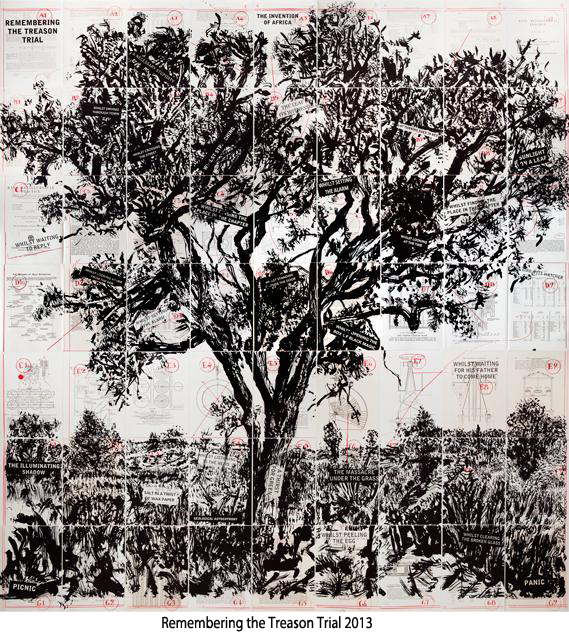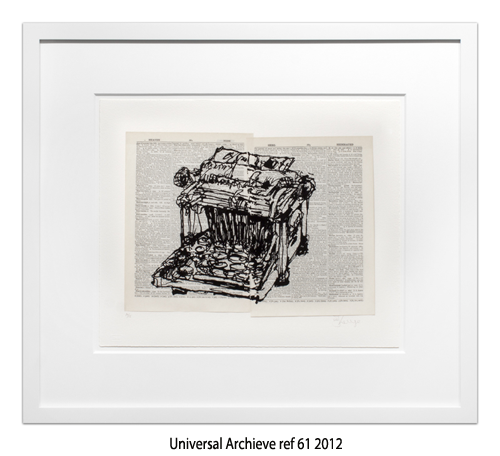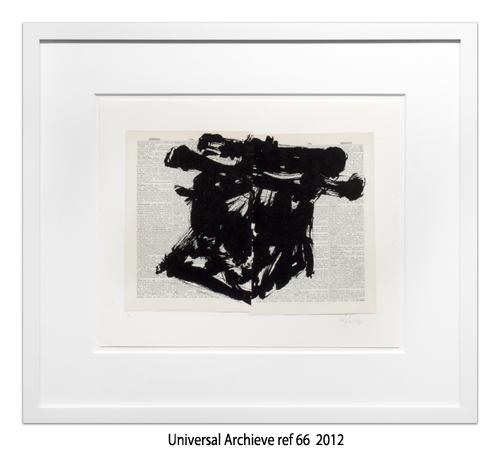by Sam Nickerson
April 24, 2014
William Kentridge’s “Universal Archive” presents typewriters in all shapes, sizes, and levels of tangibility, but is no technical study of the machine. The works are, however, a record of masterful printmaking techniques and a reminder of the fluidity of fact.
The eight typewriters on view at Barbara Krakow Gallery—which has worked with the South African artist since 1999—form a small and quiet show. There are no explanatory titles—Kentridge simply assigns each work a number—and no agenda-setting wall text. Form and technique, rather than subject matter, do the talking here.

Kentridge began this series by drawing various typewriters using different sized brushes. Some resemble the broad, meticulous strokes of Japanese ink drawings, while others seem like quick sketches scribbled in a notebook. The drawings were then transferred to linoleum plates and printed onto two old dictionary pages as if in an open book, but the lightness of Kentridge's free brush strokes are not lost in the mechanized rigidity of the printing process.
“Universal Archive” becomes an illusion; prints, copies, which retain the markings of originality.
Kentridge’s work often plays with illusions such as this to highlight the imprecision and mystery involved in the creative process. That sometimes creativity can simply mean toying around until a result appears. The appearance of the final product can mask a shift in medium and does not always reflect the work’s beginnings.
It may be a form of lighthearted play—you could easily breeze through the small show, say “those are fun,” and leave—but “Universal Archive” asks us to acknowledge the usefulness of that play, especially as a means of calling into question the formation of knowledge.
In this case, it is the repetition of typewriters over dictionary text—in other words, the immediate producer of text and its proximity to the “sourcebook” of words—that disrupts our understanding of language as something authoritative and rigid.
Perhaps “Universal Archive” also contains Kentridge’s personal discomfort with the keyboard as a place of creation. The artist once told PBS:

“A keyboard is not a very good place for me to think. Some people think very well on a keyboard. I need this kind of fidgeting of charcoal or scissors or tearing or something in my hands as if there's a different brain that's controlling how that works.”
Opposite the two walls of typewriters is a large lithograph on cotton print, Remembering the Treason Trial. While not part of “Universal Archive,” it does share certain formal qualities with the series. Like the typewriters, the tree at the forefront of Remembering the Treason Trial is printed over older found imagery. Here, the pages seem to be from mining textbooks and documents. The technical diagrams and jargon in the background oppose the dense bush scene printed over them.
“A lot of times we use an opportunity like this to say ‘hey, let’s juxtapose that, let’s see what that says,’” says gallery director Andrew Witkin of the decision to include Remembering the Treason Trial. “Isn't it nice when you have a conversation that has a little bit of texture to it?”
The title likely alludes to the 1956 Treason Trial, in which Nelson Mandela and 155 others were arrested during a raid and tried in Johannesburg. The defendants included whites, blacks, and others, displaying the diversity of apartheid’s opponents.
The print is divided into a numbered grid, allowing the viewer to see the piece as individual panels and as a whole. Some panels of Remembering the Treason Trial contain bits of text, possibly from testimony or other literature relevant to the trial. The top of the piece, panel A3 reads: “THE INVENTION OF AFRICA.” The very last panel (if it’s being read left to right), G9, simply says: “PANIC.”

Read together, the bits of text resemble the blurry and episodic, but poetic, recitation of a memory.
Remembering the Treason Trial is much more overt in its subject matter than “Universal Archive,” but both are equally archival in the way that all creative processes record the changing responses of the creator to the world and of the viewer to the work.
Transcending Passages, Maisoon Al Saleh, March 16th - April 6th, 2021
Unbound Perspectives - SEPTEMBER 26-OCTOBER 17, 2020
East Villager Billy The Artist Climbs Atop Ai Wei Wei's Fence To Shine A Light On It
A Quick Note on Transplants: Greek Diaspora Artists
Teddy Thompson’s Ultimate Funeral Mix Tape
Moray Hillary, Pre-New Reflective by Heather Zises
SELFISH, Review by Heather Zises
Winter Realm Series by Noah Becker
Paul Rousso at Lanoue Fine Art
Airan Kang, The Luminous Poem at Bryce Wolkowitz Gallery
Damien Hoar De Galvan at Carroll and Sons
Antigone, 2015, directed by Ivo van Hove
Karen Jerzyk's unsettling Parallel World
CEK - Concrete Functional Sculptures
Alexis Dahan, ALARM! At Two Rams
Do Ho Suh, Drawings, at Lehmann Maupin
Nir Hod, Once Everything Was Much Better Even the Future
Exhibition Review: Mario Schifano 1960 – 67
Subverting the Realist Impulse in the Work of Shauna Born
Linder: Femme/Objet by Erik Martiny
What We Do in the Shadows by Jemaine Clement and Taika Waititi
Justin Kimball at Carroll and Sons
Told & Foretold: The Cup in the Art of Samuel Bak, at Pucker Gallery
Collective Memory Manipulated: Sara Cwynar’s Flat Death
Accumulation: Sculptural work by Alben at Gallery Nines
Art Paris Art Fair 2013 Review
Paris Street Art Musée de la Poste
Trellises by Katherine Tzu-Lan Mann
Topography of Destruction Kemper Museum
L'art en Guerre : France 1938-1947
The Louvre Relocates to Africa
A French Priest, Tears and Fire the Art of Jean-Michel Othoniel
